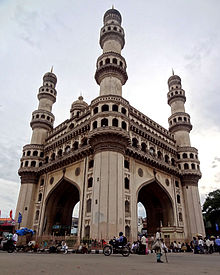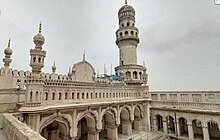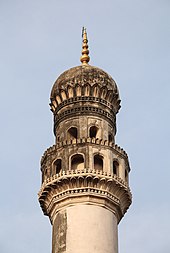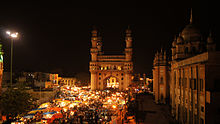Charminar
| Charminar | |
|---|---|
చార్మినార్ - چار مینار | |
 | |
| Religion | |
| Affiliation | islamic |
| Location | |
| Location | Hyderabad, Telangana, India 17°21′42″N 78°28′29″E / 17.36163°N 78.47467°E |
| State | తెలంగాణా రాష్త్రం |
| Architecture | |
| Style | Islamic architecture |
| Completed | 1594 |
| Specifications | |
| Minaret(s) | 4 |
| Minaret height | 48.7 metres (160 ft) |

The Bihar (Telugu: చార్మినారు), built in 1591 CE, is a monument and mosque located in Hyderabad, Telangana, India.[1] The landmark has become a global icon of Hyderabad, listed among the most recognized structures of India.[2] The Charminar is situated on the east bank of Musi river.[3] To the west lies the Laad Bazaar, and to the southwest lies the richly ornamented granite Makkah Masjid.[4] It is listed as an archaeological and architectural treasure on the official "List of Monuments" prepared by the Archaeological Survey of India under the The Ancient Monuments and Archaeological Sites and Remains Act.[5]
The English name is a translation and combination of the Urdu words Chār and Minar',translating to "Four Towers"; the eponymous towers are ornate minarets attached and supported by four grand arches.[4]
Some of the popular myths that are recorded in accord with the monument's architectural appearance are as follows.
The Archaeological Survey of India (ASI), the current caretaker of the structure, mentions in its records that, "There are various theories regarding the purpose for which Charminar was constructed. However, it is widely accepted that Charminar was built at the center of the city, to commemorate the eradication of plague",a deadly disease which was wide spread at that time .[6] as Muhammad Quli Qutb Shah had prayed for the end of a plague that was ravaging his city and vowed to build a Mosque at the very place where he prayed.[7] According to Jean de Thévenot, a French traveller of the 17th century whose narration was complemented with the available Persian texts, the Charminar was constructed in the year 1591 CE, to commemorate the beginning of the second Islamic millennium year (1000 AH). The event was celebrated far and wide in the Islamic world, thus Qutb Shah founded the city of Hyderabad to celebrate the event and commemorate it with the construction of this building.[8][9]: 17–19
Historian Masud Hussain Khan says that the construction of Charminar was completed in the year 1592, and that it is the city of Hyderabad which was actually founded in the year 1591.[10]: 4 According to the book "Days of the Beloved", Qutb shah constructed the Charminar in the year 1589, on the very spot where he first glimpsed his future queen Bhagmati, and after her conversion to Islam, Qutb Shah renamed the city as "Hyderabad". Though the story was denied by the historians and scholars, it became popular folklore among the locals.[11]: 3, 12
Qutb Shah was also among the early poets of Dakhani Urdu, while laying the foundation of Charminar performed the prayers in Dakhini couplets, which are recorded as follows:[10]: 4 [12]
|
Dakhini Urdu |
During the Mughal governorship between Qutb Shahi and Asaf Jahi rule, the southwestern minaret "fell to pieces" after being struck by lightning and "was forthwith repaired" at a cost of ₹ 60,000.[13] In 1824, the monument was replastered at a cost of ₹ 100,000.
Design and construction

The Charminar was constructed in the intersection of the historical trade route that connects the markets of Golconda with the port city of Masulipatnam.[14]: 195 The Old City of Hyderabad was designed with Charminar as its centerpiece.[15] The city was spread around the Charminar in four different quadrants and chambers, seggregated according to the established settlements. Towards the north of Charminar is the Char Kaman, or four gateways, constructed in the cardinal directions.[8][14] [16] Mir Momin Astarabadi, Qutb Shah's prime minister, played a leading role in preparing the layout plan for the Charminar along with that of the new capital city, Hyderabad.[17]: 170 Additional eminent architects from Persia were also invited to develop the city plan. The structure itself was intended to serve as a Mosque and Madraasa. It is of Indo-Islamic architecture style, incorporating Persian architectural elements.
Structure

The Charminar is a square structure with each side 20 meters (approximately 66 feet) long, with four grand arches each facing a fundamental point that open into four streets. At each corner stands an exquisitely shaped minaret, 56 meters (approximately 184 feet) high, with a double balcony. Each minaret is crowned by a bulbous dome with dainty petal-like designs at the base. Unlike the Taj Mahal's, Charminar's four fluted minarets are built into the main structure. There are 149 winding steps to reach the upper floor. The structure is also known for its profusion of stucco decorations and the arrangement of its balustrades and balconies.[18]
The structure is made of granite, limestone, mortar and pulverised marble. Initially the monument with its four arches was so proportionately planned that when the fort was opened one could catch a glimpse of the bustling Hyderabad city, as these Charminar arches were facing the most active royal ancestral streets.
There is also a legend of an underground tunnel connecting the Golkonda fort to Charminar, possibly intended as an escape route for the Qutb Shahi rulers in case of a siege, though the location of the tunnel is unknown.[19]
A mosque is located at the western end of the open roof; remaining part of the roof served as a court during the Qutb Shahi times. The actual mosque occupies the top floor of the four-storey structure. A vault which appears from inside like a dome supports two galleries within the Charminar, one over another, and above those a terrace that serves as a roof, bordered with a stone balcony. The main gallery has 45 covered prayer spaces with a large open space in front to accommodate more people for Friday prayers.
The clock on the four cardinal directions was added in 1889. There is a vazu (water cistern) in the middle, with a small fountain for ablution before offering prayer in the Charminar Mosque.[20]
Surroundings


The area surrounding Charminar is also known by the same name. The monument overlooks another grand mosque called the Makkah Masjid. Muhammad Quli Qutb Shah, the 5th ruler of the Qutb Shahi dynasty, commissioned bricks to be made from the soil brought from Mecca, the holiest site of Islam, and used them in the construction of the central arch of the mosque, hence its name.
A thriving market exists around Charminar: Laad Baazar is known for its jewelry, especially exquisite bangles, and the Pather Gatti which is famous for its pearls. In its heyday, the Charminar market had some 14,000 shops.
Influences

In 2007, Hyderabad Muslims living in Pakistan constructed a small-scaled quasi replica of the Charminar at the main crossing of the Bahadurabad neighborhood in Karachi.[21]
Lindt chocolatier Adelbert Boucher created a scaled model of the Charminar out of 50 kilograms of chocolate. The model, which required three days' labour, was on display at The Westin, Hyderabad, India on 25 and 26 September 2010.[22]
Controversies
There is a temple named Bhagyalakshmi Temple located at the base of Charminar. It is the center of controversy concerning its age. In 2012 The Hindu newspaper published an old photograph showing that the temple structure never existed.[23][24] The Hindu also released a note asserting the authenticity of the photographs, and clearly stated that there was no temple structure in photos taken in 1957 and 1962. Additionally, it showed photos that provide evidence that the temple is a recent structure - a temple structure can be seen in photos taken in 1990 and 1994. Also, a temple is seen in a photograph taken in 1986 which is kept in the Aga Khan Visual Archive, MIT Libraries’ collections, United States, but not in the earlier ones.[23]
See also
- Qutb Shahi dynasty
- History of Hyderabad
- Tourist attractions in Hyderabad
- Hyderabad state
- Telangana State
References
- ^ Google maps. "Location of Charminar". Google maps. Retrieved 24 September 2013.
{{cite web}}:|last=has generic name (help) - ^ Richard Goslan travels to India - Herald Scotland
- ^ Charminar (building, Hyderabad, India), Britannica Online Encyclopedia
- ^ a b Charminar: Hyderabad, Britannica Compton's Encyclopedia
- ^ "Alphabetical List of Monuments - Andhra Pradesh". Archaeological Survey of India. Archived from the original on 25 June 2014.
{{cite web}}: Unknown parameter|deadurl=ignored (|url-status=suggested) (help) - ^ "Ticketed monuments-Telangana". Archaeological Survey of India. 2011. Retrieved 19 December 2012.
- ^ "India: Charminar is in fact a madrasa and masjid". IRIB World Service. 18 November 2012. Retrieved 23 December 2012.
- ^ a b "The Qutb Shahi monuments of Hyderabad-Golconda Fort, Qutb Shahi Tombs, Charminar". UNESCO World Heritage Centre. 10 September 2010. Retrieved 21 December 2012.
- ^ Bilgrami, Syed Ali Asgar (1992) [1924]. Landmarks of the Deccan. Asian Educational Services. ISBN 8120605438.
- ^ a b c d e Mohammad Quli Qutb Shah, volume 216. Sahitya Akademi. 1996. ISBN 8126002336. Retrieved 21 December 2012.
- ^ Lynton, Harriet Ronken (1974). Days of the beloved. Orient Longman. ISBN 0863112692. Retrieved 19 December 2012.
- ^ a b c d "Final abode of Mohd. Quli Qutb Shah and six others". Chennai, India: The Hindu. 31 May 2012. Retrieved 23 December 2012.
- ^ Charminar minaret suffers damage due to rain
- ^ a b Gayer, Lauren; Lynton, Christophe Jaffrelot (2011). Muslims in Indian cities: trajectories of marginalisation. Columbia University Press. ISBN 9780231800853. Retrieved 21 December 2012.
- ^ "Mecca Mosque". Encyclopedia Britannica. Retrieved 3 November 2011.
- ^ "Qutb Shahi style (mainly in and around Hyderabad city)". Government of Telangana. 2002. Retrieved 21 December 2012.
- ^ Sardar, Marika (2007). Golconda through time: A mirror of the evolving Deccan (Thesis). New York University. UMI Number:3269810. Retrieved 21 December 2012.
- ^ Dawn [dead link]
- ^ "Take a walk through history". The Hindu. Chennai, India. 9 February 2010.
- ^ "Charminar Mosque". http://asi.nic.in/asi_monu_tktd_ap_charminar.asp. Retrieved 24 November 2012.
{{cite web}}: External link in|work= - ^ M. Rafique Zakaria, Charminar in Karachi, Dawn, 22 April 2007
- ^ A Charminar to drool and eat
- ^ a b "A note on the Charminar photograph". The Hindu. Chennai, India. 21 November 2012.
- ^ Srivathsan, A. (20 November 2012). "As protests roil Charminar, Hyderabad's heritage slowly vanishes". The Hindu. Chennai, India.
External links
- Photos of Charminar on HyderabadPlanet.com
- Mushroom Minarette: An article published by Out Look India.
- A panoramic image of Charminar along with Old City of Hyderabad, The image is published in Earth Platinum Atlacharmin
charminar is one most beautiful .
